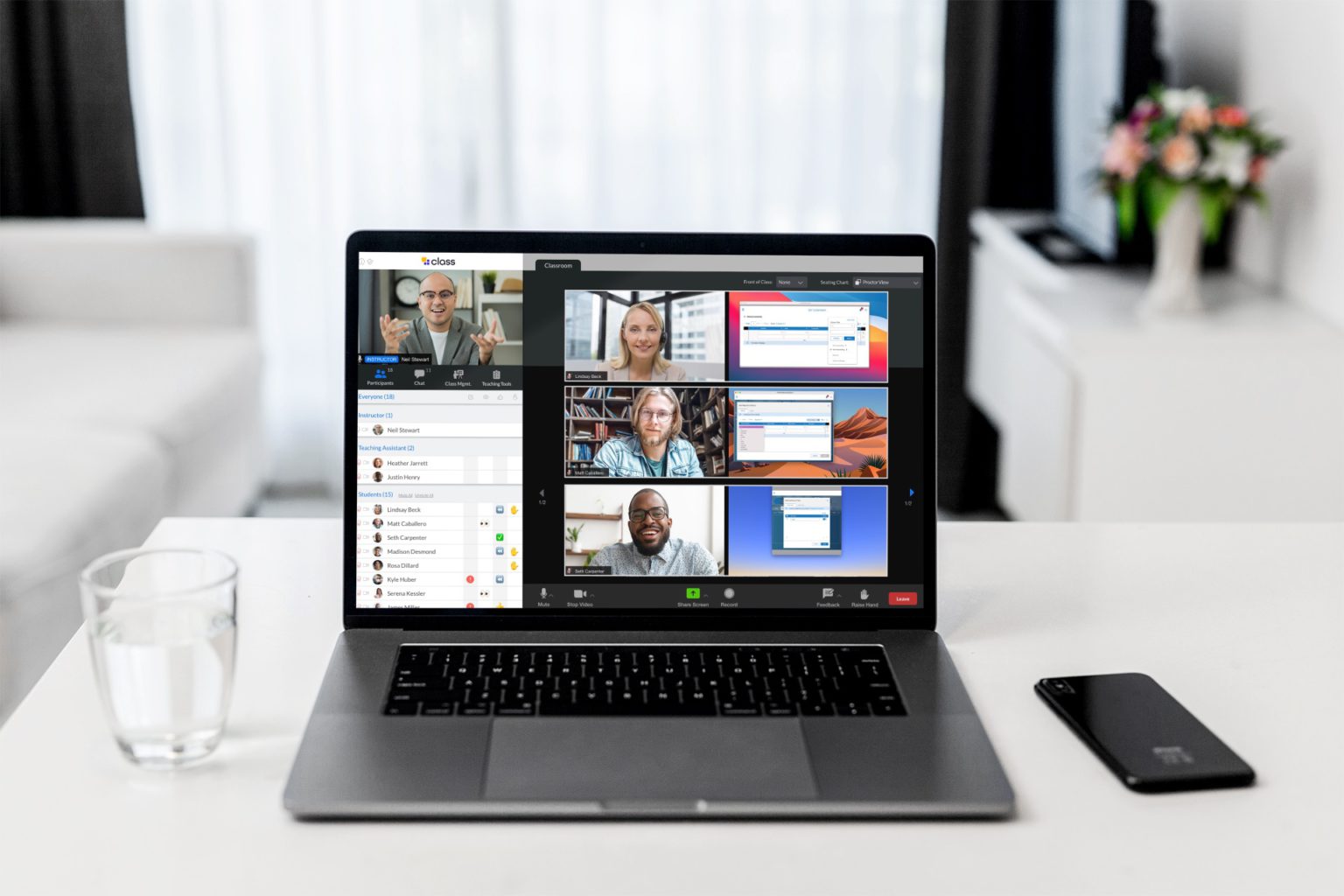
Class is the next generation virtual classroom for K-12, higher education, government agencies, and the workplace. Contact us today to schedule your live demo and see Class in action.

Class is the next generation virtual classroom for K-12, higher education, government agencies, and the workplace. Contact us today to schedule your live demo and see Class in action.

Even as companies begin to bring employees back into the workplace, most managers are finding themselves continuing to have to manage virtual teams in a hybrid work environment. While over the summer it seemed that many employees would be returning to the workplace, the Delta variant has thrown companies a curveball. Many managers will continue to manage virtual teams well into the foreseeable future.
Not surprisingly, technology tends to be a go-to aid for managing virtually. Zoom is a key example. Zoom has been one of the go-to tech tools to help managers in hybrid workplace environments– with many saying it is the best way to manage virtual teams. Here we take a look at some best practices for how to effectively manage a virtual team from those who have had experience both before and during the pandemic.
Zoom can be foundational for the effective management of a virtual or hybrid workplace. It offers a number of options to help streamline interactions and, with add-ons available through companies like Class.
Suzie Smibert is EVP and CITO for OvareGroup, where she manages a team of seven full-time employees in the US and Canada. She joined OvareGroup during the pandemic and lives and works in Canada. Technology has been a great aid as she manages staff who live and work in different time zones. “Technology enablers like Microsoft 365 have been a game-changer for our offices during the pandemic,” Smibert says. “Moving to a cloud infrastructure has sped up our efforts and work in many ways because decisions and conversations aren’t occurring through chains of emails but a quick chat or a five-minute online meeting.”
There are unexpected benefits as well, Smibert notes. For example, she says, when meeting with others online: “You can leverage the transcribe function to take notes from meetings automatically, so everyone is on the same page.”
Other tools also can be useful add-ons for virtual work, says Fox. “We rely heavily on technology—Zoom, Slack, Loom, Google Docs, VisMe, Notion, etc. Without these tools, we would not be able to function as a team.” At the same time, she says, it is important to not overdo it with the use of tech tools. “We are mindful to not use so many tools that people forget how each one of them is intended to serve us,” she says.
In addition, managers need to consider ways to use technology like Zoom to engage employees in personal ways when managing virtual teams.
Organizations using Zoom as a core technology tool for managing virtually should take full advantage of all of its functions. They have the opportunity to closely approximate in-person interactions and should make sure they are leveraging those options.
“Video technology is essential in keeping remote workers connected,” says Smibert. Some ground rules should be established. For instance, Smibert says: “We encourage everyone to turn on their cameras for video conferences. It is important from a business perspective so you can read the room during a meeting to see if everyone comprehends the information being conveyed or if a meeting is running too long and people are starting to disengage.” It is also vital, she says, for building relationships.
While employees may feel awkward at first seeing themselves on camera, over time that awkwardness will diminish, especially as they appreciate the added value of interactions where they can see colleagues’ facial expressions and even their home environments.
For those who may be sensitive about their home environments, there is the option to choose from various backgrounds or filters to maintain privacy.
Managers can play a key role in offering remote employees tips and support for maximizing the value of their online connections.

Vanessa Phan is Cardinal Education’s Managing Consultant for HR, Operations, and Private School Testing Prep Divisions. “Pandemic or not, our managers are always looking out for our employees’ welfare,” says Phan. “This just got more pronounced during this pandemic when people don’t just suffer from the physical but more so, the mental strain of the circumstances.”
Zoom can be a great way to maintain connections both during scheduled meetings and for quick check-ins. “Communication is the central force in ensuring a company functions properly,” says Phan. “We ensure that our employees have regular meetings and check-ins with their managers to foster good relationships and lessen communication gaps.”
Clearly conveying expectations is also important, says Mary Fox, co-founder and CEO at Marlow, a company that works virtually serving clients in distributed and hybrid situations. “Focus on communication and alignment of expectations for every project upfront,” says Fox. “This includes expected milestones, what the work should look like when you will meet with each other, how you will communicate with each other and who owns what.” Investing time upfront, Fox says, can both keep costs down and build morale.
It is also important to ensure that there are no “digital divides” between those off-site and those in the physical work setting. There can be a tendency, Phan says, for remote workers to feel that those who are in the office have a better situation. “Managers should build a fair work environment,” she says. “We do our best by giving equal opportunities to all employees whether they are working in-person at headquarters or working remotely from different locations.”
Managers should also be alert to signs of burnout, Phan says—both for those in the office and for those working remotely. Continued support and a mindful focus on maintaining a workplace culture that supports virtual workers is a critical best practice for managing virtual teams.
Trust is important in any work environment but deserves special emphasis when managing virtual teams. Interpersonal connections need to be more intentional and employees need to feel that they are both supported and trusted.
One practice that can negatively impact trust is remote monitoring of employee activity.
Just because technology options exist, does not necessarily mean they should automatically be used, Smibert cautions. For instance, she says: “We do not use technology to validate when or how our employees are working. Many companies put technology into place to track how long people are logged in during the day, how many keystrokes they’ve hit, or turn their camera on every so often to validate that they’re at their desks.” OvareGroup, she says, felt that doing these things would be damaging to their culture and team.
Moving forward, companies are well aware that the virtual workplace is here to stay at least to some degree. Considering how to develop a model for managing virtually that is aligned with internal practices can help ensure successful interactions across all settings.
OvareGroup will not have an official return to work policy for its IT teams, says Smibert. “If members of our team prefer to work from one of our offices, they are free to do so, but that is not a requirement,” she says. “The past year was a great proving ground to show that we can work just as efficiently and effectively in a remote or hybrid environment,” Smibert says that her team is driven by and managed by outcomes not hours. “I strongly believe that this approach builds morale and promotes a corporate culture that proves we put the needs of our employees first,” she says.
That should be the goal for any organization. Managing virtual teams can be challenging, but it can also provide unique opportunities that may not have existed before. Leveraging technology, while maintaining a clear focus on the importance of human connections, can provide a big boost for maintaining and enhancing virtual teamwork.

Class is the next generation virtual classroom for K-12, higher education, government agencies, and the workplace. Contact us today to schedule your live demo and see Class in action.

Class is the next generation virtual classroom for K-12, higher education, government agencies, and the workplace. Contact us today to schedule your live demo and see Class in action.
Get our insights, tips, and best practices delivered to your inbox

Sign up for a product demo today to learn how Class’s virtual classroom powers digital transformation at your organization.

Features
Products
Integrations